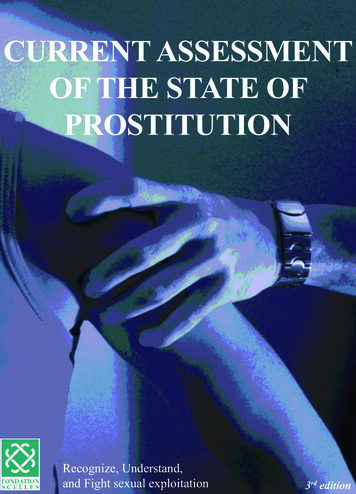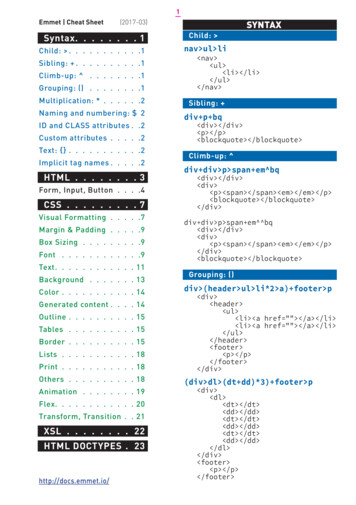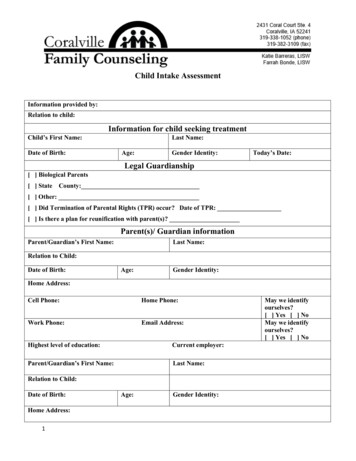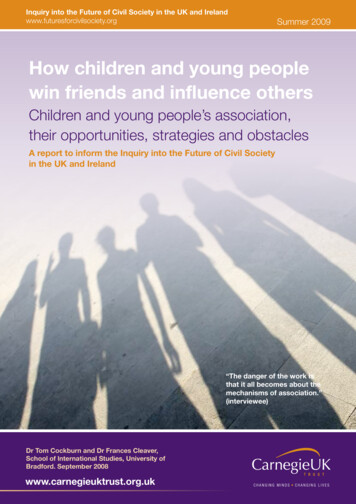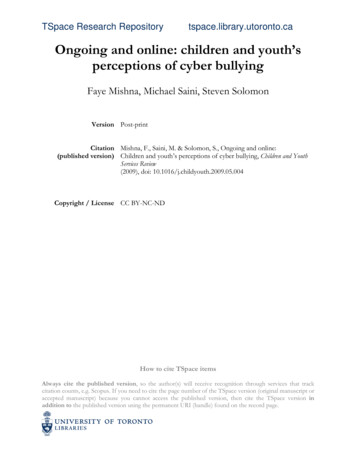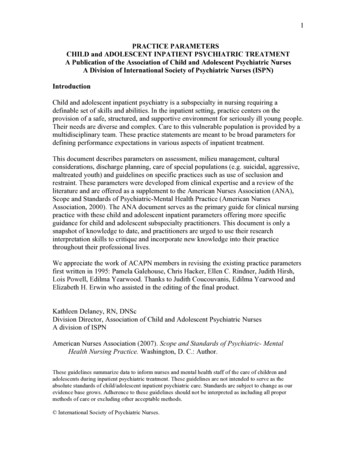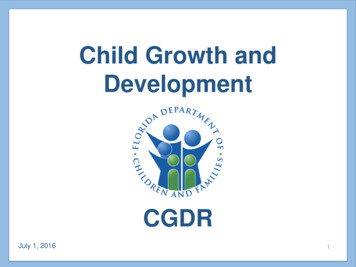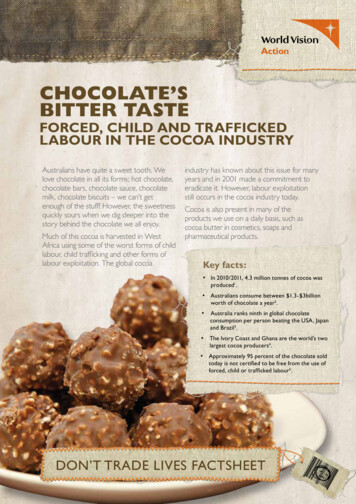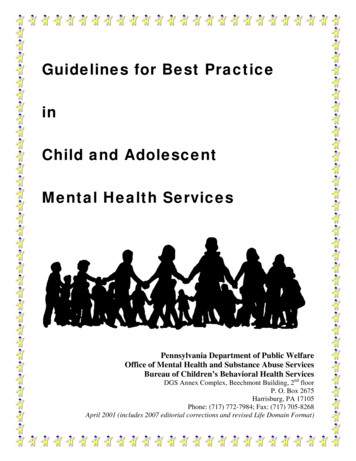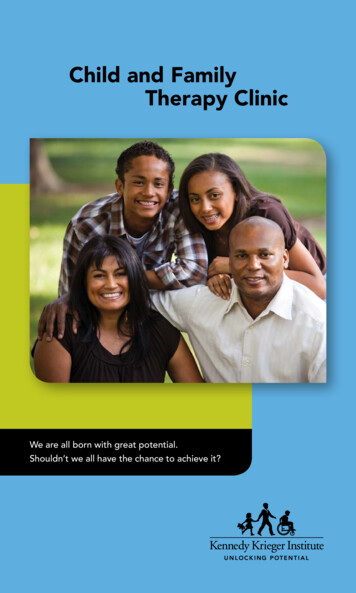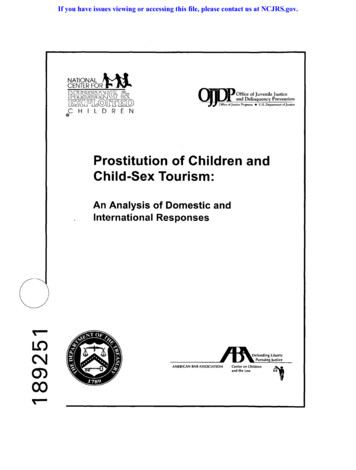
Transcription
If you have issues viewing or accessing this file, please contact us at NCJRS.gov.NATIONALCENTER FOR J O D pOf,,ce of JuvenileJusticeand DelinquencyPreventionOffice of Justice Programs U.S. Department of JusticeC H I L D R E N Prostitution of Children andChild-Sex Tourism:An Analysis of Domestic andInternational ResponsesOAMERICAN BAR ASSOCIATIONCenter on Childrenand the Law. l
Prostitution of Children and Child-Sex Tourism:An Analysis of Domestic and International ResponsesRROP ERC't'OFNational Criminal Justic R 1e enc 88 ic CJR }Box 6000Rockville, MD 20849-6000Eva J. Klain, JDAmerican Bar Association Center on Children and the Lawfor theNational Center for Missing & Exploited Children April 1999Copyright 1999 National Center for Missing & Exploited Children. All rights reserved.
AcknowledgmentsThis publication would not have been possible without the support and assistance of many staffmembers of the American BarAssociation Center on Children and the Law. Diligent researchand drafting by Katie Warwick Scrivner and meticulous citation and source checking by DeannaPeters added substantially to the final product. Thanks also to Janet Chiancone, Yolande Samerson,and Melissa Tidwell for their research support; Nefertari Johnson for her expertise on the statutorychart; and Howard Davidson for his review and comments.The comments of many outside reviewers, who graciously gave of their limited time to questionassumptions and provide suggestions for revisions, strengthened the information found in this monograph. Daniel Arma'gh of the National Center for Prosecution of Child Abuse, Lieutenant Bill Walshand Detective Joe Canibano of the Dallas (Texas) Police Department, Carol Smolenski of End ChildProstitution, Child Pornography and Trafficking of Children fbr Sexual Purposes-USA, and LauraLederer of the Women and Public Policy Program at the Kennedy School of Government, HarvardUniversity, contributed tremendously to this effort.The substantive assistance and support offered by John Rabun, Nancy Hammer, Ruben Rodriguez,and Terri Delaney of the National Center for Missing & Exploited Children (NCMEC) is gratefullyacknowledged along with the editing assistance offered by NCMEC volunteers Sheila Chapman,Sue Carruthers, Catherine Delaney, and Suzanne LappinlThe National Center for Missing & Exploited Children (NCMEC) is the national clearinghouse andresource center funded under Cooperative Agreement 98-MC-CX-K002 from the Office of JuvenileJustice and Delinquency Prevention, Office of Justice Programs, US Department of Justice.Points of view or opinions in this work are those of the author and do not necessarily represent theofficial position or policies0fthe US Department 0f Justice nor the US Department of Treasury.National Center for Missing & Exploited Children is a registered service mark of the National Centerfor Missing & Exploited Children.
Table of ContentsProstitution of Children in the United States. 1Nature and Scope of the Problem.2Precipitating Factors: Why Children Become Involved.3Running Away from Home.3Child Abuse and Neglect.3Psychological and Emotional Difficulties.4Modes of Entrance: How Children Become Involved in Prostitution.4Seasoning Techniques and Tactics of Power and Control.5Prostitution's Connection to Pornography.6Sex for Crack.6Gang Activity.6Consequences: What a Life In Prostitution Does to Children.6Victimization on the Streets: Beatings, Rape, and Murder.6Delinquency and Contact with the Juvenile-Justice System.7Health Concerns.7Psychological Disorders Including Depression and Risk of Suicide.8HIV Infection and Other Sexually-Transmitted Diseases.8Substance Abuse.9Legal Analysis.9State Law.9Definition of Prostitution.9Prostituted Children in the Juvenile Court. 10State Criminal Laws. 11Statutes Aimed at the Patrons of Prostituted Children. 11Statutes Aimed at Those Who Prostitute Children. 12Pimping. 12Pandering. 12Procuring, Compelling, Inducing Prostitution. 13Advancing or Profiting from Prostitution. 13Promoting, Managing, or Deriving Supportfrom a Prostitution Enterprise. 13Soliciting for a Prostitute. 14Criminal Liability of Parents. 15Aiding and Abetting or Accomplice Liability. 16Attempted Crimes and Lesser Included Offenses. 16Multiple Charges. 16Age-Related Defenses. 17Prostituted Children as Witnesses. 17Sentencing. 18Forfeiture. 18Restitution. 18Federal Law. 19The Mann Act. 19Other Applicable Federal Statutes.21Related Pornography Offenses.22Racketeer Influenced and Corrupt Organizations Act ederal Statutes of Assistance to Parents of Missing Children.24
The Law-Enforcement Response.24Barriers to Effective Intervention.24Effective Intervention Models.25Multij urisdictional Efforts.25Task Force.26Strike Force.26Network.27Multidisciplinary Efforts.28General Principles for Effective Intervention.28Policy and Practice Issues.29More Research on the Sexual Exploitation of Children.30Coordinated Multidisciplinary and Multijurisdictional Approaches.30Increased Social-Service Programs for At-Risk Youth.30Strategies to Meet Adolescents' Medical Needs.31Increased Outreach Efforts.31Child-Sex Tourism.32Overview of the Problem.32The Impact on Children.35The Causes.36Poverty and Other Economic Factors.36Military Presence.36Attitudes About HIV and Other Sexually-Transmitted Diseases.36Inadequate Laws and Enforcement.37The Sex Tourists.37Legal Analysis. 38International Treaties, Conventions, and Programs.38Treaties.38United Nations Charter-Based Mechanisms.39International Conventions and Covenants.39The UN Convention on the Rights of the Child.40First World Congress Against Commercial Sexual Exploitation of Children.40The World-Tourism Industry.41National Laws.42Legislative Initiatives by Destination Countries.43Legislative Initiatives by Sending Countries.43Suggested Elements.45Joint Law-Enforcement Efforts.47Policy and Practice Issues.48Cooperation Among Law-Enforcement Agencies.48Prevention, Rehabilitation, and Reintegration.48Conclusion.50Criminal Statutes Within the United States Addressing the Prostitution of Children.50International Treaties Addressing Prostitution and Trafficking of Women and Children.78Endnotes.82References. 101Resource Organizations That Address the Issue of Child Prostitution. 105North America. 105International. 107
The sexual exploitation of children through prostitution is an insidious form of commercialized violence against the world's most vulnerable citizens.1 A childhood spent inprostitution can have serious, lifelong, even life-threatening consequences for the physical, psychological, spiritual, and social development of children. 2 The prostitution ofchildren also presents substantial challenges to the justice and social-service systemscharged with the responsibility of holding offenders accountable and treating children'spresent harm, while also preventing future exploitation.In the United States, law enforcement, prosecutors, and social-service providersface many obstacles in responding to this challenging problem. Some jurisdictionshave, however, developed innovative programs and initiatives, based on multidisciplinaryand multijurisdictional models, to address the sexual exploitation of youth living on thestreets and provide the specialized services these children need.The United States is not alone in facing this challenge. Over the past decade, countriesand intemational organizations around the world have also focused substantial attention onthe destructive effects of child-sex tourism--travel to regions where child-abuse laws areweak or poorly enforced in an attempt to circumvent domestic prohibitions, or the opportunistic use of prostituted children while traveling in such regions.This monograph addresses both domestic and international responses to the prostitution of children within the United States and abroad. The first section describes the natureand scope of the problem in the United States, including why and how children becomeentangled in prostitution, and what the consequences can be for them. It then describesstate and federal statutes and selected law-enforcement initiatives combating this form ofsexual exploitation. The second section takes a broader look at the commercial-sexualexploitation of children through prostitution and child-sex tourism on a global level. Bothsections highlight policy and practice issues regarding the legal system and social-serviceresponses to prostituted children.Child-sexual exploitation in the United States takes many forms, and a number of approaches,both legal and social service, attempt to address and ameliorate its devastating effects. Butthe sexual exploitation of children through prostitution is perhaps one of the most complexand least understood forms of abuse. The children who become involved in prostitution haveoften suffered previous physical or sexual abuse and may be dealing with the attendant angerand low self-esteem. They may engage in delinquent or criminal activity, causing others to viewthem more as offenders than victims. And they very likely, and often with good reason, have adistrust of adults, even those who want to help them.Understanding the scope of sexual exploitation through prostitution--its incidence, dynamics, and consequences for children--is vital to establishing effective legal and social-serviceresponses. Who are these children? How did they become involved with prostitution? Whatare the consequences for them both in the long and short term?
I Nature and Scope of the Problem IIn trying to understand the scope of the problem of youth who engage in prostitution, it isimportant to recognize that the otten hidden population of homeless and runaway youth-from which many prostituted children are drawn--is difficult to study. 3 Data from serviceproviders may reflect only a small segment of homeless youth, and the small sample sizesof some studies cannot be generalized to a larger population. 4In addition, no reliable estimatesof the number of children engaging in prostitution in the United States exist because no one hasdefined the concept in measurable terms, s Nevertheless, while caution regarding some statisticsmay be warranted, they provide an indication of the extent of the problem that is helpful to abasic understanding of the current situation.According to one US Department of Health and Human Services report, up to 300,000prostituted children may live on the streets in the United States. 6 Many are only 11 or 12 yearsold, and some are as young as 9. vThe average age at which they enter prostitution is reportedas 14, 8and the median age of involved youth is 15.5 years. 9These children come from innercities, suburbs, and small towns, and there appears to be an increase in recruitment of middleclass youth from schools and shopping malls in the suburbs. 11The vast majority of youth involved in prostitution are girls, 2although some service providers see an increase in the number of boys. Some attribute this to a greater willingness by theboys to disclose their sexual activities. 3 Larger cities are more likely to have a higher proportionof boys involved in prostitution; however, service providers in smaller cities report seeing anincrease in prostitution activities. This possibly suggests a migration to smaller urban areas,an increase in visibility due to heightened awareness, or the greater willingness of boys to useservices. 14Prostitution of children is closely tied to life on the streets. Many youth run away fromdifficult situations at home. They may become involved in prostitution through loneliness andemotional vulnerability as well as homelessness and the need to survive. SThe children's "youngage, lack of education[,] and lack of the necessary street sense to survive alone ''16 contribute totheir need to engage in "survival sex" or the exchange of sex for food, money, shelter, drugs, orprotection that defines many of these young people's lives.17With few marketable job skills forlegitimate occupations, many turn to prostitution as a means of surviving on the streets. 8The involvement of adolescents in prostitution activities can be viewed on a continuum,with the definition of prostitution as the provision of sexual activities for food, shelter, or money(survival sex) at one end and the provision of sexual activities for approval, attention, or affection at the other. 9While money is often cited as a primary reason for engaging in prostitution,some youth report their involvement was an escape from family problems, a need to supporta drug habit, or the result of a romantic relationship. 2 Even if children first begin to prostitutefor money to survive, once in prostitution they may find themselves working to support a pimprather than themselves. Young girls are especially vulnerable to pimps who befriend them andshower them with the attention and affection (although feigned) that they did not receive athome.The decision by children to engage in prostitution should be examined in the context ofcircumstances that isolate these youth from mainstream society and the developing pressuresof life on the street when the social supports and safety net of family and community havefailed them. 2
Precipitating Factors:Why Children Become InvolvedChildren may encounter numerous difficulties in their lives that make them more vulnerable tosexual exploitation through prostitution. Homelessness, poverty, and intolerance of their sexualorientation may all affect children who either are or have been prostituted. 22General psychological and emotional problems,23housing instability,24substance abuse, educational and vocationalfailure, 25and major problems at home 26have all been cited as common precipitating factors inthe lives of prostituted children.Running Away from HomeProstitution-involved children often have extensive runaway histories. They are much more likelyto have histories of drag and alcohol abuse or to have contact with the juvenile-justice system. 27Many children who are prostituted are socially isolated and unsuccessful in school and withpeers, and this often leads them to drop out o f school. 28They also experience more frequentschool expulsions and discipline, resulting in lower levels of completed education.29Associatedproblems include parental harassment and fighting,3 as well as parental drug and alcoholabuse. 31This dysfunctional family life, combined with an unstructured and unsupervisedchildhood,32characterizes many of the lives of prostituted children and provides greaterincentive for them to leave home.The National Incidence Studies on Missing, Runaway, and Thrownaway Children inAmerica estimated that 446,700 children left home without permission and stayed away atleast overnight in 1988. An additional 127,100 children, identified as "thrownaways," wereeither told directly to leave home, were away and the caretaker refused to allow them toreturn or made no effort to find the child, or were deserted or abandoned. 33Among runaway and homeless youth, up to one-third report engaging in street prostitution--or survival sex--to achieve the basic necessities of life.34Among prostitution-involvedyouth, up to 77 percent report running away at least once. 35Surprisingly, one study showedthat more than half of the interviewed prostitution-involved youth were living with their parentsor families at the time of their most recent experience, and about 30 percent were living on thestreets or in a shelter. 36Others were staying with friends or in another unspecified arrangement.Other studies, however, show that prostitution-involved youth were less likely to live in arelative's home or shelter. If they were not on the streets, they were more likely to live withunrelated roommates, including other prostituted children or their pimps, who often demandedsexual favors in lieu of rent. 37Child Abuse and NeglectThe homes children run away from are often marked by emotional, physical, or sexual abuse,neglect,38and regular violence between the parents. Sexual abuse has a significant impact onthe probability that a runaway will become involved with prostitution. 39Early childhood abuseor neglect is a strong predictor of prostitution for girls, although it does not seem to have thesame impact on boys. 4 Sex abuse appears to indirectly increase the chance of prostitution byincreasing the risk of running away4'--"It is not so much that sexual abuse leads to prostitutionas it is that running away leads to prostitution. ''4z
While a majority of girls who enter prostitution appear to have suffered prior childhoodsexual abuse, not every child who suffers such abuse will become a runaway or prostitutedchild. But the sexual exploitation of children, combined with other family tensions or emotionaldeficiencies, increases the probability that an adolescent runaway will engage in prostitution. 43Psychological and Emotional DifficultiesWhether caused by problems in the home, or some other contributing factor, girls often experience psychological and emotional difficultiesbefore they enter prostitution. Many children whoare later prostituted are socially isolated and become entangled in a delinquent lifestyle.44On thestreets, these children seek the emotional attachments that they could not fred at home, makingthem vulnerable to those who would exploit them. In addition, fear of familial rejection orostracism based on sexual orientation may increase the likelihood that a teenager willrun away, thus increasing the likelihood that the child will engage in prostitution.45Given all of these potential difficulties, it is not surprising that the vast majority of childrenwho enter prostitution have low self-esteem and negative feelings about themselves just prior todoing so .46In an attempt to escape circumstances that they consider unbearable, many youth,once on the street, land in situations that may equal or exceed the traumas they experienced intheir homes.Modes of Entrance:How Children Become Involved in ProstitutionUnderstanding the precipitating factors that make children vulnerable to prostitution does notfully explain how they actually get drawn into "the life." Several patterns emerge including peerexchange of information on how to make money to survive and even arrangement of sexualencounters by other youth, frequently other girls. 47 Not all youth become involved for the samereasons, and the reasons may vary by location and gender. Some youth engage in prostitutionactivity explicitly for money and operate independently of pimps. Others are chronic runaways,frequently with histories of delinquency.48One of the most common modes of entrance foryoung, vulnerable girls involves the search for love and acceptance on the streets.Often a pimp, or someone working for a pimp, will approach a young girl who looksvulnerable. Pimps and their procurers frequent areas where young kids hang out--shoppingmalls, video game arcades, or bus stations--and target isolated girls. 49 They look for younggirls who are lonely or rebellious, with low self-esteem--girls who are likely to be withoutmoney or job skills.5 They prey disproportionately on young runaways because the girls arenaive and easy to control: 1The pimp's initial approach may be to just gather information about the girl's circumstances.The pimp will befriend her, sweet-talk her, and provide companionship and intimacy:z He maytry to impress her with promises of money and a comfortable lifestyle. Runaways with problemsat home are especially vulnerable to these tactics, because all they really want is to belong: 3The pimp makes the girl feel special and important, lavishing attention on her, buying her clothesand jewelry, and creating a facade of friendship and romance.54He may promise to marry heror make a lifetime commitment:5The pimp may then initiate a sexual relationship with the girl, continuing to become theprimary person in her life. This pretense of love lulls the girl into thinking theirs is a mutuallydeveloping relationship, making her emotionallyand psychologicallydependent on the pimpas a substitute for the family that abused her or turned her away.56
At this point the pimp may demand that she have sex with someone else, often a"friend" ofthe pimp, to prove her love for him. Next, she must have sex with a stranger for money. 57Soonshe finds herself prostituted as a condition of her love for him. The young girl, however, continues to think of the pimp as her boyfriend, and this perception of the relationship sustains thecontrol and abuse. After creating this dependency, the pimp begins to dominate and becomean integral part of her life.58Seasoning Techniques and Tactics of Power and ControlOnce a girl has been"turned out," the pimp may "season" her for life as a prostitute withphysical and verbal a b u s e . 59 Seasoning is meant to break her will and separate her fromher previous life so that she does not know where to turn for help .6oHe may change heridentity and move her around because constant mobility breaks any personal ties she mayhave developed and ensures new ties are only temporary. 6LThe demoralizing and dehumanizingexperience of prostitution confirms the child's poor self-image and provides another tool formanipulation by the p i m p . 6zThe pimp may withhold love and affection, or use verbal abuse, fear, and violence to controlher. 63 By that time, the girl is completely under his control.I was so much in love with him it really didn't matter as long as he was there . . . .When he told me he loved me I believed everything would work out all right. I hadbeen alone for so long and he'd told me I'd be with him for the rest of my life.64The pimp's relationship to the young girl closely parallels the dynamics of a battering relationship.65The pimp first isolates the girl from family and friends and minimizes the exploitativenature of prostitution. 66He then uses threats and intimidation to control her. Such tactics invariably involve emotional, sexual, and physical abuse. He may beat her up or threaten to leaveher. 67 The pimp creates an environment of total emotional deprivation. And most like a batterer,he uses random acts of violence to establish p o w e r . 68Physical abuse occurs in over half of pimp-prostitute r e l a t i o n s h i p s . 69 When violence is nolonger effective in controlling the girl, the pimp may use drugs or threats against her family orfriends. 7 If she becomes pregnant, the pimp uses the baby as leverage to manipulate her. 7LThe prostituted child is expected to turn over all of her earnings to the pimp and is punished ifshe fails to do so. n Because the child becomes financially dependent on the pimp, 73she mustrely on him for all necessities, and this places her even more in his "debt. ''74Pimps control 80 to 95 percent of prostitution 75and can be men or women. 76Femalepimps are ot en former prostitutes who recruit younger girls to work for them. An overwhelmingmajority of prostituted adolescent girls have pimps, but only a minority of juvenile boys do. 77Boys are significantly more likely to have arranged their own encounters. TMA young girl may also have a tendency to deny she is controlled by a pimp and may verywell consider the pimp to be her boyfriend. Also, once a girl is working for a pimp, he doesnot want to lose her as a source of income. If she wants to leave him, her new pimp oftenrequires her to pay a fee ("choosing money") to ensure her safety, because her former pimpmay use a"tracker" or bounty hunter to get her b a c k . 79
Prostitution's Connection to PornographyForcing performance in pornography is another means by which pimps achieve control over thegirls they prostitute. They may take photographs of the nude girl in the context of their relationship and then threaten to send them to the girl's family or school. 8 By learning about the girl'sfamily and friends, the pimp gets her home address and other personal information, 8 thenblackmails her. Pimps also use the pornography to control and humiliate the girl and breakher resistance. 82Pornography is often used to normalize the practice of prostitution duringthe "seasoning" process by weakening the child's resistance. 83Pimps may also show pornographic pictures to advertise their women, while customersoften want to take pictures for their later gratification. Customers may also use pornographyto describe the sexual act they want and to rationalize their behavior and their demands ofthe child?4Sex for CrackGiven the high rate of substance abuse among runaway and homeless youth, the "sex for crack"phenomenon is not surprising, but the devastation it causes is considerable. The presence ofcrack in many poor urban neighborhoods has increased the amount of street-level prostitution. 85Crack houses are also centers for sex-for-drugs exchanges. The owner of a crack house maybe a dealer or pimp who facilitates the sex-for-drugs exchange by which "the prostitute is ahouse girl who receives payment from the house man in the form of crack, room[,] andboard."86Prostituted women and girls in crack houses are "little more than indentured servants,if not outright slaves. ''87 The description of one young victim seen in a crack house illustratesthe devastation such exploitation can create: the house man gave an "emaciated, seemingcomatose" child of 14 "food, a place to sleep, and all the crack she wanted in return for herproviding sex--any type and amount of sex--to his crack-house customers. ''88 Some prostitutes describe crack as the new pimp, and younger girls who get crack from their pimps areseen as willing to do anything to feed their habits. 89The addiction is sometimes encouragedby the pimp as a means of control over the girl. 9 Gang ActivityWith crack and other drugs comes gang activity, and gangs and criminal networks are becomingincreasingly involved in the prostitution of youth. Like other illicit activities, the control of prostitution can be very profitable and therefore attractive to criminal networks and gangs.Consequences:What a Life In Prostitution Does to ChildrenVictimization on the Streets: Beatings, Rape, and MurderRunaway adolescents are particularly vulnerable to criminal victimization. They stay on thestreets at all hours of the night and engage in risky or delinquent behaviors. 9 Their involvementin prostitution exposes these children to dangerous pimps and other exploiters, as well asdangerous situations and criminal activity. This increases their risk of victimization.92
Living on the streets also exposes children to greater danger of sexual victimization beyondexploitation through prostitution. Girls are much more likely to be sexually assaulted on thestreets than boys. 93For girls, simply spending time on the streets increases their chance ofbeing victimized94--"[t]he children who have the most from which to run appear to be thosewho are also most at risk when they run.'95Not only are prostituted children in danger from street life and the pimps who preyon them, but the customers who purchase their sexual favors also pose great risks includingforced perversion, rape, and physical abuse and beatings. 96 At least two-thirds are victimizedby both customers and pimps97---violence from pimps tends to be more frequent, and violenceby customers is more dangerous but sporadic. 98Prostituted children are ot en afraid to reportthese crimes to the police because they are embarrassed and fearful that the charges wouldnot be taken s e r i o u s l y 99 o r that they may be arrested themselves. The children's lives mayoften also be in danger from murderers who target prostitutes. !Delinquency and Contact with the Juvenile-Justice SystemRunaway and homeless adolescents seek to replace the love and affection they lost or neverreceived from their families. Their own feelings of inferiority and insecurity often lead to development of a delinquent orientation. Many mistakenly see prostitution as a solution to theirproblems. 2 The isolation and lack of positive social supports that start at a very young agefor many of these children make them highly vulnerable to delinquency. 03As noted earlier, early sexual abuse elevates the risk of running away and other forms ofdelinquent or criminal behavior. 1 4Previously abused runaways are equally likely to shopliftor deal drugs as enter prostitution, t 5 suggesting that sexual abuse may indirectly affect a child'sentrance into prostitution through involvement in other criminal activities. 106Sexually-abused girls who run away are significantlymore likely than nonabused runawaygirls to engage in delinquent or criminal activities including substance abuse, petty theft, andprostitution. 7 A correlation between physical abuse and criminal activity also exists, suggestingdysfunctional parenting in general may lead to increased delinquent behavior and prostitution.t 8Health ConcernsInvolvement in prostitution by homeless youth places them at greater risk for a wide varietyof medical problems and health-compromising behaviors including drug abuse, risk of suicide,and depression. 9 Girls also experience a high rate of pregnancy, t Needs as basic as gettingenough to eat and proper nutritional balance present challenges to homeless youth. They tendto obtain food randomly and sporadically, j The food they eat may be deficient in vital nutrientswhile flush with caffeine, fats, and carbohydrates. Furthermore, their use of alcohol, cigarettes,or drugs compromises their health---even more so when money that would otherwise be usedfor food is spent on drugs. Drug use, particularly marijuana, may stimulate appetite, causing thechildren to eat more junk food. 2The health-related choices of homeless youth can easily b
defined the concept in measurable terms, s Nevertheless, while caution regarding some statistics may be warranted, they provide an indication of the extent of the problem that is helpful to a basic understanding of the current situation. According to one US Departme
